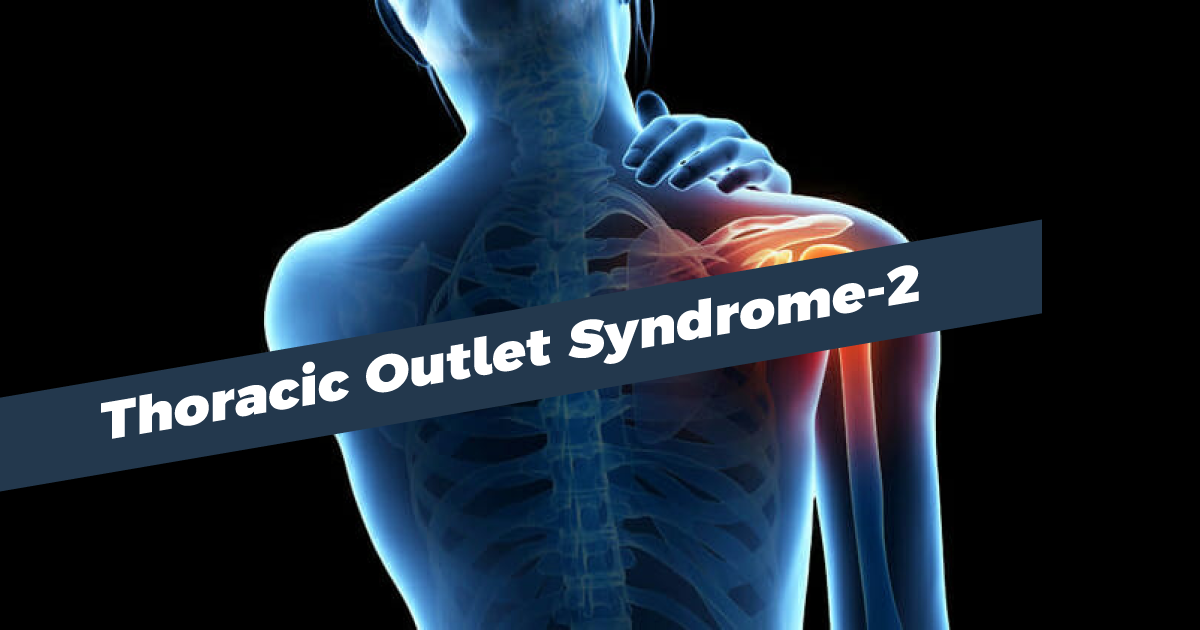Anatomical abnormalities which are causing TOS
Anatomical abnormalities that can cause thoracic outlet syndrome (TOS) include:
- Cervical ribs: Cervical ribs are extra ribs that develop above the first rib, which can cause compression in the thoracic outlet.
- Abnormalities in the first rib: An abnormality in the first rib, such as a fracture or an extra bone growth, can also cause compression in the thoracic outlet.
- Abnormalities in the scalene muscles: The scalene muscles, located in the neck, can cause compression in the thoracic outlet if they are enlarged, injured, or in spasm.
- Fibrous bands: Fibrous bands or other tissue growths in the thoracic outlet can also cause compression in the nerves and blood vessels.
- Congenital abnormalities: Some people may be born with structural abnormalities in their thoracic outlet that can lead to TOS.
It is important to note that not everyone with these anatomical abnormalities will develop TOS, and some people without these abnormalities can still develop TOS due to other factors such as trauma or repetitive motions. A thorough medical evaluation, including imaging studies such as X-rays or MRI, can help identify the underlying cause of TOS.
Cervical ribs and TOS
Cervical ribs are an anatomical abnormality that can contribute to the development of thoracic outlet syndrome (TOS). Cervical ribs are extra ribs that develop in the neck area, above the first rib. These extra ribs can put pressure on the nerves and blood vessels in the thoracic outlet, leading to symptoms of TOS.
Not everyone with cervical ribs will develop TOS, but the presence of cervical ribs can increase the risk of developing TOS. Symptoms of TOS associated with cervical ribs may include pain, numbness, or tingling in the neck, shoulder, arm, or hand. Other symptoms may include weakness or a feeling of heaviness in the affected arm.
If you have cervical ribs and are experiencing symptoms of TOS, it is important to seek medical attention. A healthcare professional can perform a thorough evaluation to determine if your symptoms are related to your cervical ribs and recommend appropriate treatment. Treatment options may include physical therapy, medication, or surgery, depending on the severity of your symptoms.
Abnormalities in the first rib and TOS
Anatomical abnormalities of the first rib can be a contributing factor to the development of thoracic outlet syndrome (TOS). The first rib is located at the top of the ribcage and plays an important role in supporting the shoulder girdle. Examples of abnormalities of the first rib that can cause TOS include:
- Cervical rib: As mentioned earlier, a cervical rib is an extra rib that develops in the neck area, above the first rib. Cervical ribs can put pressure on the nerves and blood vessels in the thoracic outlet, leading to TOS symptoms. A cervical rib is an extra rib that develops in the neck area, above the first rib. It is a type of congenital abnormality and is present at birth. Cervical ribs are relatively rare and are estimated to occur in approximately 0.5-2% of the population.
Cervical ribs can contribute to the development of thoracic outlet syndrome (TOS) by compressing the nerves and blood vessels in the thoracic outlet. Symptoms of TOS associated with a cervical rib may include pain, numbness, or tingling in the neck, shoulder, arm, or hand. Other symptoms may include weakness or a feeling of heaviness in the affected arm.
An extra cervical rib abnormality, also known as a supernumerary rib, is a rare anomaly in which a person has an additional cervical rib in addition to the normal complement of ribs. This anomaly can also contribute to the development of TOS by compressing the nerves and blood vessels in the thoracic outlet.
If you have symptoms of TOS associated with a cervical rib or an extra cervical rib abnormality, it is important to seek medical attention. A healthcare professional can perform a thorough evaluation to determine if your symptoms are related to a cervical rib or extra cervical rib abnormality and recommend appropriate treatment. Treatment options may include physical therapy, medication, or surgery, depending on the severity of your symptoms.
- Enlarged first rib: In some cases, the first rib may be larger than normal, which can compress the nerves and blood vessels in the thoracic outlet and lead to TOS symptoms. An enlarged first rib is a type of anatomical abnormality that can contribute to the development of thoracic outlet syndrome (TOS). The first rib is an important bone that connects the spine to the sternum (breastbone) and forms part of the thoracic outlet. If the first rib is enlarged or abnormally shaped, it can compress the nerves and blood vessels in the thoracic outlet and cause TOS symptoms.
Symptoms of TOS associated with an enlarged first rib may include pain, numbness, or tingling in the neck, shoulder, arm, or hand. Other symptoms may include weakness or a feeling of heaviness in the affected arm. These symptoms may worsen with activities that involve overhead movements, such as reaching or lifting.
An enlarged first rib can be caused by a variety of factors, including congenital abnormalities, trauma, or repetitive motions. It can also be associated with medical conditions such as arthritis or tumors.
If you have symptoms of TOS associated with an enlarged first rib, it is important to seek medical attention. A healthcare professional can perform a thorough evaluation to determine if your symptoms are related to an enlarged first rib and recommend appropriate treatment. Treatment options may include physical therapy, medication, or surgery, depending on the severity of your symptoms.
- Abnormal curvature: The first rib may have an abnormal curvature that can compress the nerves and blood vessels in the thoracic outlet and lead to TOS symptoms. An abnormal curvature of the first cervical rib is a type of anatomical abnormality that can contribute to the development of thoracic outlet syndrome (TOS). The first cervical rib is a small bone that connects the first thoracic vertebra to the clavicle (collarbone) and forms part of the thoracic outlet. If the first cervical rib has an abnormal curvature, it can compress the nerves and blood vessels in the thoracic outlet and cause TOS symptoms.
Symptoms of TOS associated with an abnormal curvature of the first cervical rib may include pain, numbness, or tingling in the neck, shoulder, arm, or hand. Other symptoms may include weakness or a feeling of heaviness in the affected arm. These symptoms may worsen with activities that involve overhead movements, such as reaching or lifting.
An abnormal curvature of the first cervical rib can be caused by a variety of factors, including congenital abnormalities, trauma, or repetitive motions. It can also be associated with medical conditions such as arthritis or tumors.
If you have symptoms of TOS associated with an abnormal curvature of the first cervical rib, it is important to seek medical attention. A healthcare professional can perform a thorough evaluation to determine if your symptoms are related to an abnormal curvature of the first cervical rib and recommend appropriate treatment. Treatment options may include physical therapy, medication, or surgery, depending on the severity of your symptoms.
- Fracture or dislocation: Trauma to the first rib, such as a fracture or dislocation, can cause compression of the nerves and blood vessels in the thoracic outlet and lead to TOS symptoms. Fracture or dislocation of the first cervical rib is a type of injury that can contribute to the development of thoracic outlet syndrome (TOS). The first cervical rib is a small bone that connects the first thoracic vertebra to the clavicle (collarbone) and forms part of the thoracic outlet. If the first cervical rib is fractured or dislocated, it can compress the nerves and blood vessels in the thoracic outlet and cause TOS symptoms.
Symptoms of TOS associated with a fracture or dislocation of the first cervical rib may include pain, numbness, or tingling in the neck, shoulder, arm, or hand. Other symptoms may include weakness or a feeling of heaviness in the affected arm. These symptoms may worsen with activities that involve overhead movements, such as reaching or lifting.
Fracture or dislocation of the first cervical rib can be caused by a variety of factors, including trauma, such as a car accident or a fall. It can also be associated with medical conditions such as osteoporosis or tumors.
If you have symptoms of TOS associated with a fracture or dislocation of the first cervical rib, it is important to seek medical attention. A healthcare professional can perform a thorough evaluation to determine if your symptoms are related to a fracture or dislocation of the first cervical rib and recommend appropriate treatment. Treatment options may include immobilization with a brace or sling, physical therapy, medication, or surgery, depending on the severity of your injury and symptoms.
It is important to seek medical attention if you have symptoms of TOS, especially if you have an anatomical abnormality of the first rib. A healthcare professional can perform a thorough evaluation to determine the underlying cause of your symptoms and recommend appropriate treatment. Treatment options may include physical therapy, medication, or surgery, depending on the severity of your symptoms.
Keywords: Thoracic Outlet Syndrome, TOS, brachial plexus, nerves, anatomy, scalene muscle, cervical rib, first rib, costoclavicular syndrome, Pancoast tumor, neurofibroma, hematomas, Vascular TOS, Neurogenic TOS, Non-specific TOS, Brachial Plexus Neuralgia, treatment options, physical therapy, surgery, occupational therapy, chiropractic care, acupuncture, medications.
Last Revision: 10.03.2023

